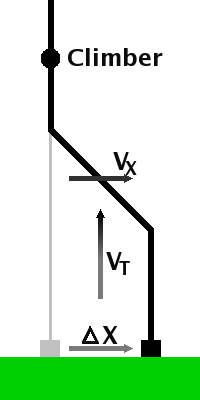|
⇤ ← Revision 1 as of 2011-06-23 20:56:47
Size: 5366
Comment:
|
Size: 5381
Comment:
|
| Deletions are marked like this. | Additions are marked like this. |
| Line 54: | Line 54: |
| ||{{attachment:SEdisplacement.png}}||aaa<<BR>><<BR>>aaa<<BR>><<BR>>aaa<<BR>><<BR>>aaa<<BR>><<BR>>aaa<<BR>><<BR>>aaa<<BR>><<BR>>aaa<<BR>><<BR>>}}|| | ||{{attachment:SEdisplacement.png}}||MORE LATER<<BR>><<BR>>aaa<<BR>><<BR>>aaa<<BR>><<BR>>aaa<<BR>><<BR>>aaa<<BR>><<BR>>aaa<<BR>><<BR>>aaa<<BR>><<BR>>|| MORE LATER |
| Line 57: | Line 59: |
Space Elevator Displacement
The lower portion of the space elevator, below 2000km altitude, must be able to move to avoid satellites and space debris in LEO orbit. According to the ESA Meteoroid and Space Debris Terrestrial Environment Reference ( MASTER-2005) there are more than 600,000 objects larger than 1 cm (0.4 in) in orbit. Assuming a 1000 kilometer altitude circular orbit, the average orbital period is 105 minutes, and these objects cross the equator twice in that time.
The current NORAD tracking accuracy (for a tiny fraction of those objects) is 1 kilometer. Given that radar return power goes down as the 4th power of the distance, we can expect the "1km accuracy" is much better at 200km altitude, and much worse at 2000 km altitude. As we will see, the higher altitude objects are challenges in many ways.
The average debris flux passing through a 1 km wide (east-west) vertical band is about 15 per hour. The number passing through a 1km wide cylindrical column will be higher, as the flux will be divided by the average of the sine of the inclination. Assuming an average inclination of 45 degrees, the flux passing through our cylindrical column will be about 21 per hour. The average time interval between objects passing through our cylinder is 172 seconds.
But that is an average interval. If we assume an average rate of 0.35 objects per minute, the probability of 0, 1, 2, 3 ... per minute will follow a Poisson distribution:
- Table 1: Objects per minute, 1 km cylinder
Number |
Probability |
Occurences |
|
|
per 10 years |
0 |
0.704688 |
3706377.48 |
1 |
0.246641 |
1297232.12 |
2 |
0.043162 |
227015.62 |
3 |
0.005036 |
26485.16 |
4 |
0.000441 |
2317.45 |
5 |
0.000031 |
162.22 |
6 |
0.000002 |
9.46 |
7 |
0.000000 |
0.47 |
Over the course of 10 years, we have an even chance of having to dodge 7 objects, along a 2000 kilometer high vertical column, in one minute. That will be difficult, the ribbon will have multiple jigs and jogs propagating up it. Probably impossible, especially as climbers on the ribbon will prevent rapid movement for the ribbon above them. So some of those objects will pass within our cylinder - if the ribbon is 20 cm wide, each of those objects has a 1/5000 chance of impacting the ribbon.
Further, this assumes accurate and complete debris catalogs and ephemerides. As we enter the "Kessler Syndrome Era", many debris objects will be created by over-the-horizon collisions, with new orbital parameters, and will travel for many orbits before they are encountered by the space debris tracking network. The only reliable way of characterizing and avoiding debris is to Radar.
So, make two bold assumptions:
We are doing our own tracking, with complete coverage to 2000 km altitude, and
We can characterize incoming object trajectories accurately, to within 20 meters
That changes our table above. Assume we need 5 minutes to move the ribbon 20 meters at 2000 kilometers altitude (difficult, as we will see below!). Our collision table now becomes
- Table 2: Objects per five minutes, 20 meter cylinder
Number |
Probability |
Occurences |
|
|
per 10 years |
0 |
0.965605 |
1015739.65 |
1 |
0.033796 |
35550.89 |
2 |
0.000591 |
622.14 |
3 |
0.000007 |
7.26 |
4 |
0.000000 |
0.06 |
Over the course of 10 years, there will be about 7 times when we will need to avoid 3 objects at once over a 5 minute period. This time, the chance of an impact is 0.2/20, or 1 in 100, so if we can only avoid 2 at once, we will have a 7% chance of collision and possible failure from these events. Even very good tracking does not keep us completely out of trouble!
The climber filtering problem
The speed of propagation of a transverse jog of the ribbon is the proportional to the square root of the specific loading. A ribbon loaded to 30 Mega Yuri will have a transverse (back and forth, not up and down) propagation speed of 5500 m/s . However, the worst case is that there is a climber above this section of ribbon, slackening the ribbon below to a lighter loading. That slows down speed of propagation, which is unfortunate in two ways, as we will soon see. Assume that the ribbon below a climber is slackened to 16 MYuri, for a propagation speed of 4000 m/s.
Since the ribbon is tapered, we will get mechanical reflections. The result is that the heavier ribbon above will move less than the ribbon below.
The worst case is that the climber is in between us and a section of ribbon we have to move. The mass of the climber will resist lateral movements. Assume the climber is at 1200km altitude, and we need to move the ribbon just above it.
|
MORE LATER |
MORE LATER

